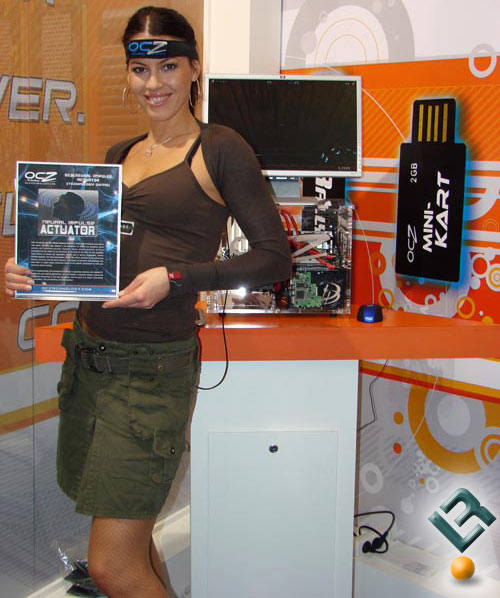CeBIT 2007 – OCZ’s Neural Impulse Actuator
CeBIT 2007 Highlights – The Neural Impulse Actuator
For years the CeBIT trade show has set the stage for unveiling exciting, futuristic technology and this year is no different. OCZ Technology has demonstrated the NIA (Neural Impulse Actuator) which is an innovative input device that takes is the next step towards a full integration of central and peripheral nerve activity into controlling personal computers. Neural signals are decoded and combined with each other to create unique commands based on the specific permutation of brain, eye, and facial muscle activity. This device truly does plug you into a computer and is set to revolutionize the industry, specifically PC productivity and gaming applications.

The OCZ Neural Impulse Actuator looks like nothing more than a head band with a wire coming out of it, but this is far from something that you’d see Maria Sharapova sporting around the tennis court. It does look sporty though and the booth babe that OCZ had modeling it seemed happy to donate her neural activity.

A closer look at the Neural Impulse Actuator (and the model) reveals the bulge of the three neural sensors that are resting on the forehead of the user. Unlike an electrocardiography (ECG) machine commonly used in the medical industry the OCZ neural impulse actuator doesn’t use electrode cream, which is a good thing because the last thing gamers would want to do is lube up before playing their favorite game.

With the neural impulse actuator removed the neural sensor pads can be clearly seen. Neural activity generates electrical potentials that are picked up by the three electrodes that are on the forehead of the user. The actuator then separates the electrical activities into three classes of neural and electromyographic signals. That is electro oculographic, electro encephalographic and electromyographic signals for those who are wondering! These signals are said to reflect the activities of the extraocular muscles, the brain, and the facial muscles.

These signals are then decoded and combined with each other to create unique commands based on the specific permutation of brain, eye and facial muscle activity. What’s really weird about the technology is that it really does work! OCZ informed LR that the technology behind the neural impulse actuator is ready to go and they will be bringing the actuator to market. Unlike other products this device hooks into existing games now and allows you to play games like Unreal Tournament already. There is a learning curve to using one of these, but it’s pretty easy and should take ~2 minutes to get the device working.
The biggest market for this device will be gamers as they will be able to use the neural impulse actuator in combination with the a mouse to control the shooting, jumping, running, etc. in FPS games. OCZ hopes to bring the actuator to market by years end and hope to bring it to market at around $300 USD.

Comments are closed.